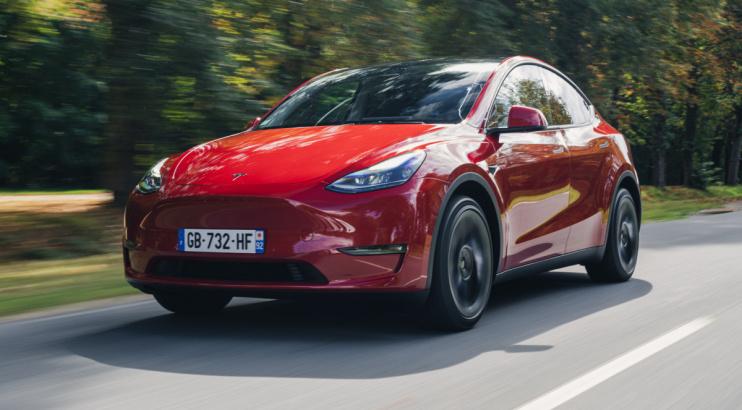Test Tesla Model Y Great autonomy: our opinion at the wheel of the electric SUV
We would immediately call him like an old acquaintance this Tesla Model Y, so much does he look like two drops of water to the Model 3 sedan with which he shares his technique. A drop of water that has taken on volume. Six centimeters in length, seven in width and above all 18 cm in height including 2.7 cm of ground clearance (16.7 cm), to make it an SUV only available in four-wheel drive, with one electric motor per axle.
A 4×4 that doesn't look like it but that splits it rather efficiently since its aerodynamics do not really suffer from its growth, with a very good Cx of 0.23, allowing its manufacturer to announce 507 km of 'autonomy. It is still 107 km less than the Model 3. On our 231 km city-road journey, combining all types of rhythms, from the calmest to the most lively, the computer showed a consumption of 20.3 kWh/ 100km. Over 100 km at conventional speed, it fell to an economical value of 17.8 kWh/100 km. Although Tesla does not communicate the capacity of its battery, figures around 75 kWh come back regularly from several sources, which makes it possible to estimate a real autonomy of around 400 km without driving effort. And necessarily less on the highway.
=> Tesla price: the range in detail
=> Tesla Model 3 Performance: 600 kilometers behind the wheel
If the body of the Model Y follows some aeronautical principles, its interior is inspired by the railway sector. The trunk is a real station hall, providing 971 liters of volume divided between the 854 l. on the back of the bench seat and the 117 l. from the front tray, located under the hood. It's better than the very generous Model 3 and its 649 l. in total. But that's not all. By lowering the rear seats (in three parts instead of two), the space freed up reaches 2,041 l. and unlike the sedan, the opening benefits from a tailgate, facilitating loading.
Second-row passengers gain some headroom and legroom. They will have the opportunity to be able to tilt their backrest when the center one will still benefit from a flat floor but also from a slightly less comfortable seat. On US trims, there's an optional third row, adding two fold-out seats that cost $3,000. There is little to hope that the €7,000 difference between the Model Y and the Model 3 will offer this side of the Atlantic this potential “Eco class” at no extra cost. A significant difference for this SUV which, apart from the trunk and the bench, hardly changes anything.
Everything in the same place and even a little too much

What does not change a bit is the almost complete absence of buttons on a very refined dashboard. The 15″ touchscreen tablet, which has largely contributed to the brand's reputation, is still used to control functions as varied as navigation, air conditioning, driving aid settings and headlights. When stationary, everything is very simple. By driving… less. Groping in the menus to accelerate the rhythm of the wiper blades in the pouring rain or activating the fog lamps without seeing more than 50 meters would have deserved small actuators and more.
What would happen if this screen froze and became unresponsive? This happened to us before it reset a few minutes later. Pressing the two buttons on the steering wheel for several seconds allows you to restart it without waiting. Still need to be stopped. A rare but not isolated technical problem. We will not go so far as to throw stones at him. Firstly because it would not solve the problem, but above all because while taking care of everything on board, this panel is very reactive and very fluid.
=> Why is the Tesla Model S Plaid called Plaid?
=> The incredible interior of the Tesla Model S
An omnipresent travel companion in a bright space, thanks to the huge glazed roof whose separation with the rear window is set back compared to that of the Model 3, thereby limiting rear vision. The cameras help, unlike the 12.1m turning circle. complicating certain U-turns. The steering can be adjusted on three levels in order to force less, but remains consistent and very direct with two turns lock to lock. The force of the energy recovery is not adjustable and just becomes more progressive in the "Comfort" mode, while doubling the acceleration values. In "Standard" mode, the starts are great, the times even better. Tesla does not communicate the power either, but the engines are those of the "3", with 441 cumulative hp for the latter. And all this in a great silence.
Cash movements are not non-existent but well contained, at the cost of a firmness relatively far from the family spirit. The seats partially compensate but do not support enough. At least the heading is excellent. Well supported by Michelin tires discreetly revealing inside all the efforts they provide to contain the two tons when the rhythm in curves accelerates.
To go further, it will be necessary to keep some under the foot and take advantage of the large network of Superchargers delivering up to 250 kW to find approximately 60% of battery in 15 min. The competition will soon have access to it, like the Mustang Mach-E and its even larger screen (15.5″) or the Hyundai Ioniq 5 and Skoda Enyaq iV, taking more care of their comfort. At equivalent endowment, these rivals are worth about the same price. Unlike them, the Tesla Model Y doesn't offer as many trim choices and starts at €59,990. Avoid changing color or switching to 20″ rims if you want to take advantage of the €2,000 bonus, accessible to vehicles under €60,000.
Notice
WE love :
We like less:
Our opinion
Unsurprisingly, we find the whole universe (and design) of the Model 3, with a substantial surplus of trunk volume. Too bad the "Y" makes it pay so much. Fortunately, he retains his excellent overall performances.
Price
Tesla Model Y Long range Version tested: €59,990 From €59,990 Average manufacturer consumption/ during the test (kWh/100 km): 16.9/20.3 CO2 (g)/ bonus: 0/2,000 € Fiscal horsepower 11 HP Country of manufacture China
Electric, from 441 hp to 513 hp, from €59,990 to €66,990 Performance version available in early 2022
Technical sheet
Engine: 276 hp permanent magnet synchronous electric rear + 165 hp asynchronous electric front Transmission: 1-speed all-wheel drive Battery: 360 V lithium-ion Cumulative power (hp): 441 Cumulative torque (Nm): 493 Combined manufacturer autonomy (km): 507 Weight (kg): 2,003 Length.xwidth.xheight. (m): 4.75×1.92×1.62 Wheelbase (m): 2.89 Maximum speed (km/h): 217 0 to 100 km/h (s): 5.0 Charging time Fast charging station 250 kW: 270 km in 15 minutes, Wallbox 11 kW: 70 km/hour or approximately 7h15 from 0 to 100%, 220 V household socket: 15 min/hour or approximately 34 hours from 0 to 100% Standard tyres: 255 /45 R 19 Tires tested: 255/40 R 20 Michelin Pilot Sport EV
Interior
Front/rear elbow width (cm) 143/137 Rear legroom (cm) 103 Rear locker 5/double (l) 854/2,041 Front locker (l) 117
Competitors
Ford Mustang Mach-E Standard Range AWD 269 hp, from €56,500
Hyundai Ioniq 5 HTRAC Executive 306 hp, from €59,900
Skoda Enyaq iV 80X 265 hp, from €51,130
To read on auto-moto.com:
Tesla Model S Plaid: watch the record lap at the Nürburgring
Used Tesla Model S: our opinion, from 36,000 Euros
Tesla Model Y: discover the interior and the info in video
Tesla Model S Plaid: it is already tearing off the parquet floor at Pikes Peak - VIDEO








